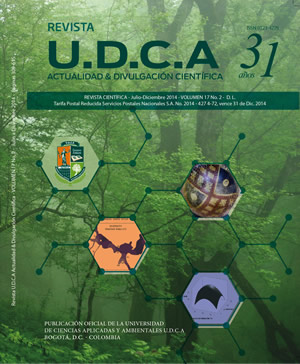Crecimiento de plántulas de maíz (Zea mays L. var. Porva) en solución nutritiva con baja relación (ca+mg+k)/al
Growth of maize seedlings (Zea mays L. var. Porva) in nutrient solution with low (ca+mg+k)/al ratio
Contenido principal del artículo
Resumen
La toxicidad por aluminio, se relaciona en la productividad de cultivos establecidos en suelos ácidos con alta disponibilidad de Al3+. Frecuentemente, a valores de pH inferiores a 5,0, existe un efecto tóxico en especies agrícolas importantes, debido a la solubilidad del Al3+. Este trabajo, se llevó a cabo en Tunja, Boyacá, Colombia, para determinar el efecto tóxico del aluminio en el crecimiento de plántulas de maíz (Zea mays L. var. Porva). Las plántulas crecieron en solución nutritiva gaseosa (macro y micronutrientes), en relaciones (Ca+Mg+K)/Al 1; 0,75 ó 0,5, mediante la adición de Al2(SO4)3.18H2O en relación con las bases (Ca, Mg y K), contenidas en la solución. Al medio de crecimiento de las plantas testigo, no se les adicionó aluminio. El pH, se ajustó a 5,5 para todos los tratamientos. Las plántulas fueron analizadas cuando se hicieron evidentes los síntomas por toxicidad de aluminio. Se estimó la longitud radical total, el peso seco y el área foliar; adicionalmente, se calculó la relación raíz/vástago. El área foliar, peso seco y longitud radical total no mostraron diferencias estadísticas entre los tratamientos con relaciones (Ca+Mg+K)/Al 1 a 0,5; sin embargo, todos los tratamientos con aluminio fueron estadísticamente diferentes al control. Los valores de la relación raíz/vástago mostraron una tendencia inversamente proporcional con la relación (Ca+Mg+K)/Al; estos resultados implican que la variedad de maíz Porva es muy sensible al aluminio, independientemente si la relación bases/aluminio se encuentre baja o en balance.
Palabras clave:
Descargas
Datos de publicación
Perfil evaluadores/as N/D
Declaraciones de autoría
- Sociedad académica
- Universidad de Ciencias Aplicadas UDCA
- Editorial
- Universidad de Ciencias Aplicadas y Ambientales U.D.C.A
Detalles del artículo
Referencias (VER)
AGRONET. 2008. Área cosechada, producción y rendimiento de maíz tradicional, 1987-2007. Disponible desde Internet en: http://www.agronet.gov.co/www/htm3b/excepcionesNuke/cargaNet/netcarga16.aspx?cod=16&submit=Ver+Reporte&reporte=Producci%u00f3n+nacional+por+producto&file=2007816102236_20058417048_agronetevaarea rendimientoyproduccionporproductoporagno.rpt&codigo=16&excepcion=1&fechaI=1987&producto=Ma%u00edz+tradicional&fechaF=2007 (con acceso 18/11/08)
ANDERSSON, M.E.; BRUNET, J. 1993. Sensitivity to H- and Al-ions limiting growth and distribution of the woodland grass Bromus benekennii. Plant Soil. 153:243-254.
ARCOS, A.L. 2008. Determinación de calosa para seleccionar genotipos de maíz resistentes a aluminio. Disponible desde Internet en: http://www.ciat.cgiar.org/training/pdf/2008_05_21_L_Arcos.pdf (con acceso 18/11/2008).
ASHER, C.J. 1991. Benefical elements, functional nutrients and possible new essential elements. En: Mortvedt, F.; Cox, R.; Shuman, L.M.; Welch, R.M. eds. Micronutrients in agriculture. Soil Sci. Soc. Am. 4:703-723.
BELL, L.C.; EDWARDS, D.G. 1986. The role of aluminium in acid soil infertility. En: Latham, M. ed. Soil management under humid conditions, Bangkok, Thailand, p.201-223.
BENNET, R.J.; BREEN, C.M. 1991. The aluminium signal: New dimensions to mechanisms of aluminium tolerance. Plant Soil. 149:87-94.
BLANCAFLOR, E.B.; JONES, D.L.; GILROY, S. 1998. Alterations in the cytoskeleton accompany aluminum-induced growth inhibition and morphological changes in primary roots of maize. Plant Physiol. 118:159-172.
CASIERRA-POSADA, F. 2001. Fundamentos fisiológicos, bioquímicos y anatómicos del estrés por aluminio en vegetales. Rev. Comalfi. 28(2):8-19.
CASIERRA-POSADA, F. 2002. Alteraciones inducidas por aluminio en el citoesqueleto de las plantas. Rev. Comalfi. 29(2):23-28.
CASIERRA-POSADA, F.; CÁRDENAS-HERNÁNDEZ, J.F. 2007. Influencia del aluminio sobre el crecimiento de la raíz en coliflor (Brassica oleracea L. var. Botrytis, Hib. Nevada F1). Rev. U.D.C.A Act. & Div. Cient. 10(1):149-157.
CASIERRA-POSADA, F.; NIÑO-MEDINA, R.C. 2007. Solubilidad y reacción del aluminio en el suelo. Ciencia y Agricultura 5(2):7-17.
CLUNE, T.S.; COPELAND, L. 1999. Effects of aluminium on canola roots. Plant Soil. 216: 27-33.
COMIN, J.J.; BARLOY, J.; BOURRIÉ, J.; TROLARD, F. 1999. Differential effects of monomeric and polymeric aluminium on the root growth and on the biomass production of root and shoot of corn in solution culture. Eur. J. Agron. 11:115-122.
De LEÓN, C.; NARRO, L.; TORRES, L.G. 2000. Corpoica H-108; primer híbrido de maíz en Colombia para suelos ácidos de la Altillanura Plana. Villavicencio, Corpoica. Plegable divulgativo No. 17. 2p.
De LEÓN, C.; NARRO, L.; TORRES, L.G.; Caicedo, S. 2001. Híbrido de maíz amarillo Corpoica Altillanura H-111. Villavicencio, Corpoica. Plegable divulgativo No. 2. 5p.
El-SHATNAWI, M.K.J.; MAKHADMEH, I.M. 2001. Ecophysiology of the plant-rhizosphere system. J. Agron. Crop Sci. 187:1-9.
ESPINOSA, J. 2001. Acidez y encalado de los suelos . En: Silva M., F., ed. Fertilidad de suelos: Diagnóstico y control. Soc. Col. Ciencia Suelo. p.113-128.
EZAKI, B.; KATSUHARA, M.; KAWAMURA, M.; MATSUMOTO, H. 2001. Different mechanisms of four aluminum (Al)-resistant transgenes for Al toxicity in Arabidopsis. Plant Physiol. 127:918-927.
FAO. 2004. Faostat. Disponible desde Internet en: http://faostat.fao.org/site/567/DesktopDefault.aspx?PageID=567. (con acceso 09/03/08).
GUNNING, B.E.S.; STEER, M.W. 1996. Plant cell biology: Structure and function. Jones and Bartlett ediciones, Sudbury, MA. 130p.
ICA INSTITUTO COLOMBIANO AGROPECUARIO. 1992. Fertilización en diversos cultivos, quinta aproximación. Produmedios. Bogotá. 64p.
JANHUNEN, S.; PALOMÄKI, V.; HOLOPAINEN, T. 1995. Aluminium causes nutrient imbalance and structural changes in the needles of Scots pine without inducing clear root injuries. Trees. 9:134-142.
KAYAMA, M. 2001. Comparison of the aluminium tolerance of Miscanthus sinensis Anders. and Miscanthus sacchariflorus Bentham in hydroculture. Int. J. Plant Sci. 162:1025-1031.
KIDD, P.S.; PROCTOR, J. 2000. Effects of aluminium on the growth and mineral composition of Betula pendula Roth. J. Exp. Bot. 51(347):1057-1066.
KINRAIDE, T.B. 1993. Aluminum enhancement of plant growth in acid rooting media. A case of reciprocal alleviation of toxicity by two toxic cations. Physiol. Plant. 88:619-625.
KINRAIDE, T.B. 1997. Reconsidering the rhizotoxicity of hydroxyl, sulphate and fluoride complexes of aluminum. J. Exp. Bot. 48:1115-1124.
KOLLMEIER, M.; FELLE, H.H.; HORST, W.J. 2000. Genotypical differences in aluminum resistance of maize are expressed in the distal part of the transition zone. Is reduce basipetal auxin flow involved in inhibition of root elongation by aluminum? Plant Physiol. 122(3):945-956.
KONISHI, S.; MIYAMOTO, S.; TAKI, T. 1985. Stimulatory effects of aluminium on tea plants grown under low and high phosphorus supply. Soil Sci. Plant Nutr. 31:361-368.
LAZOF, D.B.; HOLLAND, M.J. 1999. Evaluation of the aluminum-induced root growth inhibition in isolation from low pH effects in Glycine max, Pisum sativum and Phaseolus vulgaris. Australian J. Plant Physiol. 26:147-157.
LLUGANY, M., POSCHENRIEDER, C.; BARCELO, J. 1995. Monitoring of aluminium-included inhibition of root elongation in four maize cultivars differing in tolerance to Al and proton toxicity. Physiol. Plant. 93:265-271.
MA, J.F. 2005. Plant root responses to three abundant soil minerals: Silicon, aluminum and iron. Crit. Rev. Plant Sci. 24(4):267-281.
MARSCHNER, H. 1995. Mineral nutrition of higher plants. 2a ed. Academic Press, Londres. p.606-613.
MATSUMOTO, H. 1991. Biochemical mechanism of the toxicity of aluminum and the sequestration of aluminum in plant cells. En: R.J. Wright, V.C. Baligar, R.P. Murrmann, eds. Plant-Soil Interactions at Low pH. Kluwer Academic Publishers, Dordrecht, The Netherlands, p.825-838.
MENGEL, K.; KIRKBY, E.A. 1987. Soil as a plant nutrient medium. En: Principles of Plant Nutrition, 4th Ed., International Potash Institute, p.56-61.
OSAKI, M., WATANAD, T.; TADAMO, T. 1997. Beneficial effect of aluminium on growth of plants adapted to low pH soils. Soil Sci. Plant Nutr. 43:551-563.
PANDA, S.K.; SINGHA, L.B.; KHAN, M.H. 2003. Does aluminium phytotoxicity induce oxidative stress in greengram (Vigna radiata)?. Bulg. J. Plant Physiol. 29(1-2):77-86.
RAYBURN, A.L.; BIRABAR, D.P.; BULLOCK, D.G.; McMURPHY, L.M. 1993. Nuclear DNA content in F1-hybrids of maize. Heredity. 70:294-304.
RENGEL, Z. 1992. Disturbance of cell Ca2+ homeostasis as a primary trigger of Al toxicity syndrome. Plant Cell Environ. 15:931-938.
RYAN, P.R.; DiTOMASO, J.M.; KOCHIAN, L.V. 1993. Aluminium toxicity in roots: An investigation of spatial sensitivity and the role of the root cap. J. Exp. Bot. 44:437-446.
SÁNCHEZ, P.A. 1977. Advances in management of Oxisols and Ultisols in tropical South America. En: Proceedings of the international seminar on soil, environment, and fertility management in intensive agriculture. Tokyo, Japón. p.535-566.
SALINAS, J. 1988. Adaptación de plantas a toxicidades de aluminio y manganeso. En: Fertilidad de suelos: Diagnóstico y control. S.C.C.S. Bogotá. p.379-400.
SILVA, I.R.; SMYTH, T.J.; ISRAEL, D.W.; RAPER, C.D.; RUFTY, T.W. 2001. Magnesium ameliorates aluminum rhizotoxicity in soybean by increasing citric acid production and exudation by roots. Plant Cell Physiol. 42:546-554.
SILVA, I.R.; SMYTH, T.J.; MOXLEY, D.F.; CARTER, T.E.; ALLEN, N.S.; RUFTY, T.W. 2000. Aluminum accumulation at nuclei of cells in the root tip: Fluorescence detection using lumogallion and confocal laser scanning microscopy. Plant Physiol. 123:543-552.
SYMEONIDIS, L.; ABOU AUDA, M.M.; YUPSANIS, T. 2003. Aluminium toxicity effects on Cucumis melo and response of diphosphonucleoside kinases. Biologia, Bratislava. 59:133-139.
TESFAYE, M.; TEMPLE, S.J.; ALLAN, D.L.; VANCE, C.P.; SAMAC, D.A. 2001. Overexpression of malate dehydrogenase in transgenic alfalfa enhances organic acid synthesis and confers tolerance to aluminium. Plant Physiol. 127:1836-1844.
Von UEXKÜLL, H.R; MUTERT, E. 1995. Global extent, development and economic impact of acid soils. En: Date, R.A.; Grundon, N.J.; Raymet, G.E.; Probert, M.E., eds. Plant-Soil Interactions at low pH: Principles and Management. Kluwer Acad. Publ., Dordrecht, The Netherlands, p.5-19.
WETZEL, J.B.; AREF, S.; BALIGAR, V.C.; RAYBURN, A.L. 1999. A lack of nuclear DNA content variability among wheat near isolines differing in aluminium response. Ann. Bot., 83:725-728.
YANG, Y.H.; CHEN, S.M.; ABDULLAHI, B.A.; 2001. Alleviation effect of different ratios of Al to Ca on Al toxicity for morphological growth of mungbean seedling. J. Plant Nutr. 24:573-583.
ZHANG, W.H.; RENGEL, Z. 1999. Aluminium induces an increase in cytoplasmic Ca2+ in intact wheat roots. Australian J. Plant Physiol. 26:401-409.







